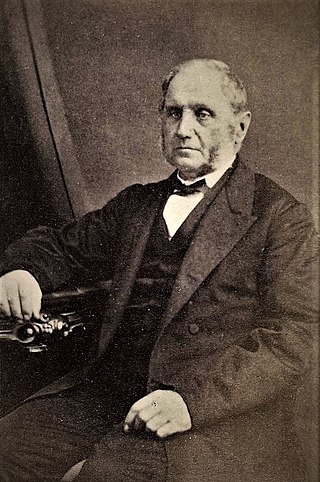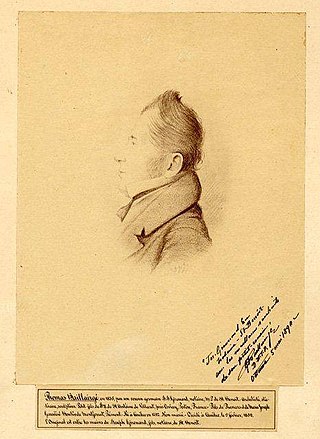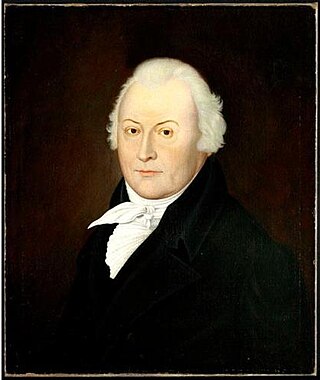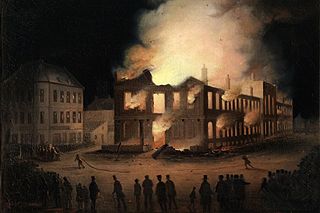
Villa Maria is a subsidized private Catholic co-educational high school in Montreal, Quebec, Canada that offers both a francophone and an anglophone stream. Founded in 1854 as a boarding school for girls, it stopped boarding students in 1966 and opened, in August 2016, to boys in the seventh grade. Today, there are roughly 950 students in the French sector and 800 students in the English sector with an average class size of 34 students. Current tuition as of the 2021–2022 school year is $4,500 with $1,900 in extra mandatory fees.

Villa-Maria is a Montreal Metro station in the borough of Côte-des-Neiges–Notre-Dame-de-Grâce in Montreal, Quebec, Canada. It is operated by the Société de transport de Montréal (STM) and serves the Orange Line. It is located in the Westmount Adjacent area of the Notre-Dame-de-Grâce neighbourhood, beside the Décarie Expressway trench.

Fassett is a municipality and village in the Papineau Regional County Municipality in Quebec, Canada, located on the north shore of the Ottawa River east of Montebello.

Old Montreal is a historic neighbourhood within the municipality of Montreal in the province of Quebec, Canada. Home to the Old Port of Montreal, the neighbourhood is bordered on the west by McGill Street, on the north by Ruelle des Fortifications, on the east by rue Saint-André, and on the south by the Saint Lawrence River. Following recent amendments, the neighbourhood has expanded to include the Rue des Soeurs Grises in the west, Saint Antoine Street in the north, and Saint Hubert Street in the east.

Bonsecours Market is a two-story domed public market located in Montreal, Quebec, Canada at 350 Rue Saint-Paul in Old Montreal. For more than 100 years, it was the main public market in the Montreal area. It also briefly accommodated the Parliament of United Canada for one session in 1849.
The Legislative Council of the Province of Canada was the upper house for the Province of Canada, which consisted of the former provinces of Lower Canada, then known as Canada East and later the province of Quebec, and Upper Canada, then known as Canada West and later the province of Ontario. It was created by The Union Act of 1840. With the lower house, the Legislative Assembly of the Province of Canada, the two houses constituted the Parliament of the Province of Canada.

Pierre Beaubien was a physician and political figure in Canada East, Province of Canada. Trained in medicine in France, he practised and taught medicine in Montreal. He was involved in real estate development in Montreal, contributing to the creation of Outremont. He served two partial terms in the Legislative Assembly, the lower house of the Parliament of the Province of Canada, as a member of the French-Canadian Group under the leadership of Louis-Hippolyte LaFontaine.

Thomas Baillairgé was both a wood carver and architect, following the tradition of the family. He was the son of François Baillairgé and the grandson of Jean Baillairgé, both men being termed architects under the definition of the time. The family had been based in Quebec since 1741 and Thomas attended English school and then the Petit Séminaire de Québec. During the latter time, he would also have begun to learn wood carving and architecture.

Michel-Eustache-Gaspard-Alain Chartier de Lotbinière, 2nd Marquis de Lotbinière, though to keep political favour with the British he never used the title. He was seigneur of Vaudreuil, Lotbinière and Rigaud. He was the Speaker of the House of Commons in Lower Canada who saw to it that the French language was recognised as equal to English in the Quebec Parliament, where a painting of him giving the speech still hangs above the Speaker's chair.

The Ritz-Carlton Montréal is a luxury hotel located at 1228 Sherbrooke Street West, on the corner of Drummond Street, in Montreal, Quebec. Opened in 1912, it was the second Ritz-Carlton hotel in North America after one in New York City. Its name was originally licensed by César Ritz directly, and while the hotel is now part of the chain managed by the Ritz-Carlton Hotel Company, it retains its original branding stylization.

John Ostell was a British-Canadian architect, surveyor and manufacturer, was born in London, England and emigrated to Canada in 1834, where he apprenticed himself to a Montreal surveyor André Trudeau to learn French methods of surveying. In 1837 he married Eleonore Gauvin, a member of a prominent French Catholic family in the city. His marriage ensured entry to French Canadian society, he was appointed diocesan architect for Montreal. In 1849 he formed a partnership with his nephew Henri-Maurice Perrault (1828–1903), this was the formation of one of the first architectural dynasties in Canada.

Notre-Dame Street is a historic east–west street located in Montreal, Quebec, Canada. It runs parallel to the Saint Lawrence River, from Lachine to the eastern tip of the island in Pointe-aux-Trembles, then continuing off the island into the Lanaudière region.

Notre-Dame-de-Bonsecours is a municipality in the Outaouais region of Quebec, Canada. It is located along the Ottawa River, about 55 kilometres (34 mi) east of Gatineau. It was formerly known as Notre-Dame-de-Bon-Secours-Partie-Nord. It is the least populated municipality in the Papineau Regional County Municipality.

The burning of the Parliament Buildings in Montreal occurred on the night of April 25, 1849, in Montreal, the then-capital of the Province of Canada. The way the matter was handled by then co-prime ministers of the united Province of Canada, Sir Louis-Hippolyte Lafontaine and Robert Baldwin, helped develop the Canadian democratic tradition.
The timeline of Montreal history is a chronology of significant events in the history of Montreal, Canada's second-most populated city, with about 3.5 million residents in 2018, and the fourth-largest French-speaking city in the world.

Duke of Kent House or Kent House is situated on the corner of Rue Saint-Louis and Haldimand, behind the Château Frontenac in Quebec City, named after its most famous resident Prince Edward, Duke of Kent and Strathearn. Though altered and transformed since its original construction, the most part of its foundations and of the first floor walls date back to about 1650, making it one of the oldest houses, if not the oldest house in Quebec City. In 1759, the Articles of Capitulation of Quebec were signed within the house. The present edifice has remained largely unchanged since 1819. It served as the French Consulate from 1980 to 2015.

Hôpital Notre-Dame is a hospital in Montreal, Quebec, Canada. It is located on Sherbrooke Street East in the borough of Ville-Marie, across from La Fontaine Park. It was established in 1880, and has been at its present site since 1924.

Château Vaudreuil was a stately residence and college in Montreal, Quebec, Canada. It was constructed between 1723 and 1726 for Philippe de Rigaud, Marquis de Vaudreuil, as his private residence by Gaspard-Joseph Chaussegros de Léry. Though the Château Saint-Louis in Quebec City remained the official residence of the Governors General of New France, the Château Vaudreuil was to remain as their official home in Montreal up until the British Conquest in 1763. In 1767, it was purchased by the Marquis de Lotbinière. He sold it in 1773, when it became the Collège Saint-Raphaël. It was destroyed by a fire in 1803.

The High School of Montreal was an English-language high school founded in 1843, serving Montreal, Quebec, Canada, in the area eventually known as the Golden Square Mile. It was less formally known as Montreal High School and from 1853 to 1870 was called the High School of McGill College, or the High School Division.
Basilique Notre-Dame is the French name for a number of Basilicas dedicated to the Virgin Mary. These include:



















